 W
WAllegory of Virtue and Vice or The Choice Between Virtue and Vice or The Choice of Hercules is a painting by Paolo Veronese, created circa 1565 in Venice, Italy and now located in the Frick Collection. It is a large-scale allegorical painting depicting Hercules' struggle between virtue and vice, personified here by the figures of the two women physically pulling him in different directions.
 W
WAllegory of Wisdom and Strength or Wisdom and Strength is a painting by Paolo Veronese, created circa 1565 in Venice, Italy and now located in the Frick Collection. It is a large-scale allegorical painting depicting Divine Wisdom personified on the left and Hercules, representing Strength and earthly concerns, on the right. Wisdom gazes heavenward while Hercules looks down on jewels below him. The conflict between divine and mortal affairs is central in this allegorical painting.
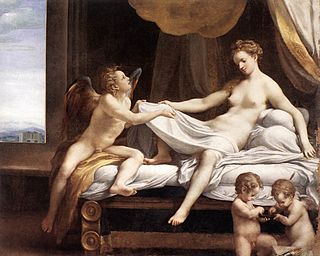 W
WDanaë is a painting by the Italian Renaissance artist Correggio, executed around 1531 and now in the Galleria Borghese in Rome.
 W
WThe Death of Actaeon is a late work by the Italian Renaissance painter Titian, painted in oil on canvas from about 1559 to his death in 1576 and now in the National Gallery in London. It is very probably one of the two paintings the artist stated he had started and hopes to finish in a letter to their commissioner Philip II of Spain during June 1559. However, most of Titian's work on this painting possibly dates to the late 1560s, but with touches from the 1570s. Titian seems never to have resolved it to his satisfaction, and the painting apparently remained in his studio until his death in 1576. There has been considerable debate as to whether it is finished or not, as with other very late Titians, such as the Flaying of Marsyas, which unlike this has a signature, perhaps an indication of completion.
 W
WThe myth of Diana and Actaeon can be found in Ovid’s Metamorphoses. The tale recounts the unfortunate fate of a young hunter named Actaeon, who was a grandson of Cadmus, and his encounter with chaste Artemis, known to the Romans as Diana, goddess of the hunt. The latter is nude and enjoying a bath in a spring with help from her escort of nymphs when the mortal man unwittingly stumbles upon the scene. The nymphs scream in surprise and attempt to cover Diana, who, in a fit of embarrassed fury, splashes water upon Actaeon. He is transformed into a deer with a dappled hide and long antlers, robbed of his ability to speak, and thereafter promptly flees in fear. It is not long, however, before his own hounds track him down and kill him, failing to recognize their master.
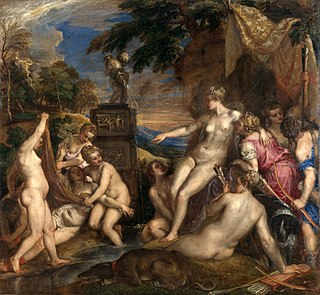 W
WDiana and Callisto is a painting completed between 1556 and 1559 by the Italian late Renaissance artist Titian. It portrays the moment in which the goddess Diana discovers that her maid Callisto has become pregnant by Jupiter. The painting was jointly purchased by the National Gallery and the Scottish National Gallery for £45 million in March 2012. Along with its companion painting Diana and Actaeon it is displayed on an alternating basis between London and Edinburgh. There is a later version by Titian and his workshop in the Kunsthistorisches Museum in Vienna.
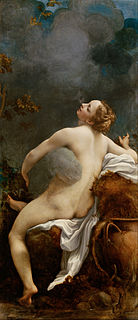 W
WJupiter and Io is a painting by the Italian High Renaissance artist Antonio da Correggio. It is now in the Kunsthistorisches Museum of Vienna, Austria.
 W
WThe Madonna and Child Enthroned with Saints, also known as the Colonna Altarpiece, is a painting by the Italian High Renaissance artist Raphael, c. 1504. It is housed in the Metropolitan Museum of Art of New York City. It is the only altarpiece by Raphael in the United States.
 W
WThe Mill is a painting by Dutch baroque artist Rembrandt Harmenszoon van Rijn. It is in the permanent collection of the National Gallery of Art in Washington DC. For a long time, the attribution to Rembrandt was regarded as doubtful; it has been restored in recent years, although it is not universally accepted. The painting was formerly in the Orleans Collection. It was once owned by Peter Arrell Brown Widener.
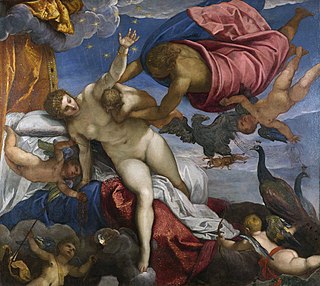 W
WThe Origin of the Milky Way is a painting by the Italian late Renaissance master Jacopo Tintoretto, in the National Gallery, London, formerly in the Orleans Collection. It is an oil painting on canvas, and dates from ca.1575–1580.
 W
WThe Orléans Madonna is a c.1506-1507 painting of the Madonna and Child by Raphael. It was acquired by Philippe II, Duke of Orléans for the Orléans collection, giving it its present name. It is now in the Musée Condé in Chantilly.
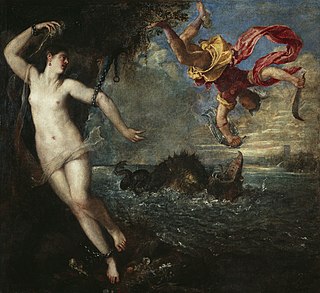 W
WPerseus and Andromeda is a painting by the Italian Renaissance artist Titian, now in the Wallace Collection in London. It was painted in 1554–1556 as part of a series of mythological paintings called "poesie" ("poetry") intended for King Philip II of Spain. The paintings took subjects from the Roman poet Ovid's Metamorphoses, in this case Book IV, lines 663–752, and all featured female nudes.
 W
WThe Raising of Lazarus is a large altarpiece of 1517–1519 by the Italian High Renaissance artist Sebastiano del Piombo, for which Michelangelo supplied drawings for some figures. Intended for Narbonne Cathedral in France, it is now normally in Room 18 of the National Gallery in London, where it is "NG1", the first painting catalogued at the founding of the gallery in 1824. Until 25 June 2017 it is in the exhibition Michelangelo & Sebastiano at the National Gallery, together with several of the preparatory drawings for it by both artists, and letters between them.
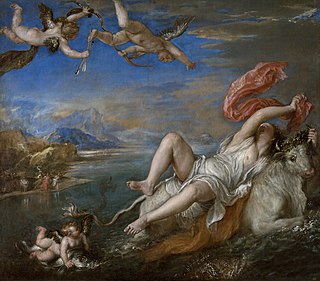 W
WThe Rape of Europa is a painting by the Italian artist Titian, painted ca. 1560–1562. It hangs in the Isabella Stewart Gardner Museum of Boston, Massachusetts. The oil-on-canvas painting measures 178 by 205 centimetres.
 W
WThe Three Ages of Man is a painting by Titian, dated between 1512 and 1514, and now displayed at the Scottish National Gallery in Edinburgh. The 90 cm high by 151 cm wide Renaissance art work was most likely influenced by Giorgione’s themes and motifs of landscapes and nude figures—Titian was known to have completed some of Giorgione’s unfinished works after Giorgione died at age 33 of the plague in 1510. The painting represents the artist’s conception of the life cycle. Childhood and manhood are synonymous with earthly love and death approaching old age are drawn realistically. Titian’s widely chosen topic in art history, ages of man, mixed with his own allegorical interpretation make The Three Ages of Man one of Titian’s most famous works.
 W
WVenus Anadyomene, is a c. 1520 oil painting by Titian, depicting Venus rising from the sea and wringing her hair, after her birth fully-grown. Venus, said to have been born from a shell, is identified by the shell at bottom left. It is smaller than usual in the birth of Venus scenes, such as Botticelli's, and is just intended to identify the subject rather than be a boat-like vessel for Venus, as in Sandro Botticelli's The Birth of Venus and other depictions.
 W
WA composition of Venus and Adonis by the Venetian Renaissance artist Titian has been painted a number of times, by Titian himself, by his studio assistants and by others. In all there are some thirty versions that may date from the 16th century, the nudity of Venus undoubtedly accounting for this popularity. It is unclear which of the surviving versions, if any, is the original or prime version, and a matter of debate how much involvement Titian himself had with surviving versions. There is a precise date for only one version, that in the Prado in Madrid, which is documented in correspondence between Titian and Philip II of Spain in 1554. However, this appears to be a later repetition of a composition first painted a considerable time earlier, possibly as early as the 1520s.